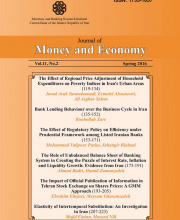۱.
The aim of this study is to examine the nonlinear effects of fiscal and monetary policies on inflation during 1990:3 to 2013:1 based on threshold model. First lag of the liquidity growth is recognized as threshold variable with threshold value estimated at 6.37 percent. In low liquidity growth, the results indicate that inflation expectations and the lagged liquidity growth are the most important determinants of inflation. In high liquidity growth, effects of the variables including liquidity, development and con-current expenditure, exchange rate, budget deficit and inflationary expectations are much stronger than low one. GDP and its lag in both regimes are anti-inflationary as expected. Oil revenues have no inflationary effects in both regimes, so it seems that the effect of oil shocks on inflation is captured by other variables such as exchange rate and money growth. Based on results, it seems that liquidity growth can be considered as the most important factor for regime change in the relationship between inflation and fiscal and monetary policies in the economy. So if economy benefits from the low liquidity regime, it can prevent the inflationary effects of variables like government expenditure or exchange rate and use the opportunity to control inflation expectations. It is recommendable, in low liquidity regime to use fiscal, monetary and exchange rate policies to stimulate production and real sector with low inflationary effects. Keywords: Inflation, Inflationary Regimes, Threshold Model, Nonlinear Model JEL Classification: E31, H5, C01
۲.
کلیدواژهها:
Microstructure Noise high frequency data Maximum Likelihood Estimation Portfolio Switching
Noise is essential for the existence of a liquid market, and if noise traders are not present in the market, the trade volume will drop severely and an important aspect of the market philosophy will be lost. However, these noise traders bring noise to the market, and the existence of noise in prices indicates a temporary deviation in prices from their fundamental values. In particular, high-frequency prices carry a significant amount of noise that is not eliminated by averaging. If the level of noise in stock prices remains high for a period of time, it can be identified as a risk factor because it indicates that the deviation from fundamental values has been sustained. In this paper, after estimating the microstructure noise in high-frequency prices through a modified parametric approach, using a portfolio switching method, we compared the performance of portfolios having a high level of noise with the performance of portfolios having a lower level of noise and concluded that the risk of the high noise level presents itself as a risk premium in the future return and that asset pricing models which capture the systematic risks cannot capture the noise risk in prices. Keywords: Microstructure noise; High frequency data; Quasi-maximum Likelihood Estimation (QMLE); Portfolio switching. JEL Classification: C13, G11, G12
۳.
Drastic changes and turbulence in macro-economic factors have the greatest impact on banks target market attractiveness in Iran. It is assumed that conventional segmentation models at the corporate level are not efficient for banking system. This study aims to develop a new segmentation model at the industry level for banks of Iran. For this purpose, structures and variables at the industry level were identified and defined by reviewing the literature and with the help of bank experts in focus group sessions. Then, data of ISIC 3-digit factories with 50 and more employees were extracted from Iran Statistic Center and Tehran Stock Exchange databases during 2005-2013. We used Hierarchical Cluster analysis in each year and identified 4 study groups across 9 years. We found that identified groups are significantly different regarding industry size, deposit and loan market size, industry growth, deposit and loan market growth, profitability, investment risk, and transaction with other industries. Keywords: Macro-segmentation, Manufacturing Industries, Segmentation based on industries, Hierarchical Clustering, Banking. JEL Classification: E44, G21, L60, M31, C67, C82
۴.
This paper investigates the asymmetric effects of monetary policy on economic growth over business cycles in Iran. Estimating the models using the Hamilton (1989) Markov-switching model and by employing the data for 1960-2012, the results well identify two regimes characterized as expansion and recession. Moreover, the results show that an expansionary monetary policy has a positive and statistically significant effect on economic growth during recession, in expansionary regimes while the effects are stronger during recessions than expansions as predicted by finance constraints models. By using time-varying transition probability Markov-switching models, the results also show that an expansionary monetary policy raises the probability of switching from a recession to an expansion but reduces the probability of switching from an expansion to a recession. Keywords: Monetary policy, Business cycles, Asymmetry, Markov-switching. JEL Classification: E52, E32, G10
